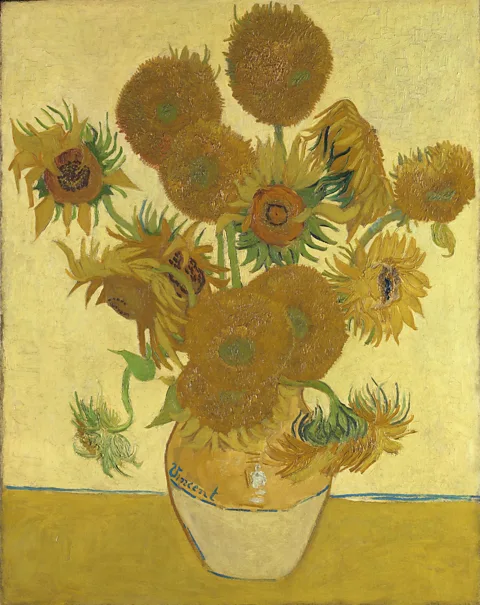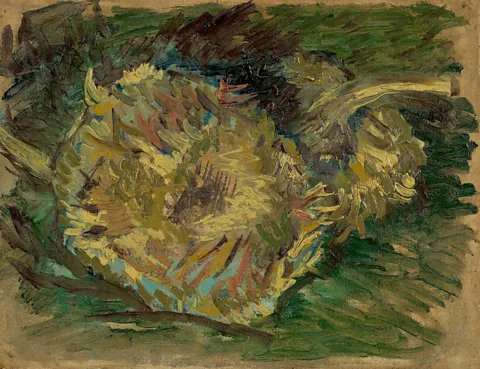 The National Gallery, London
The National Gallery, LondonThey helped to make Vincent van Gogh among the most famous and influential painters in the history of art. Why did sunflowers obsess him and so many other artists before and since?
When we think about Vincent van Gogh, most people will instantly call to mind his iconic, boldly executed and citrus-warm sunflowers. It’s a piece of brand recognition that the artist fully intended. “The sunflower is mine”, he once wrote, betraying his desire to be publicly associated with this brazen, man-sized plant and its swaggering, flame-maned crown of petals. Sunflowers clearly had a deep significance for him. So what, if anything, did Vincent intend to symbolise with his beloved helianthus annuus?
Alongside Starry Night, the National Gallery in London’s Sunflowers is perhaps his most recognisable artwork. But the artist also painted 10 other canvases that focused on these flowers. They came in three short bursts of inspiration. First was a series of four created in Paris in 1887. The second batch of four canvases were created in less than a week after his move to the southern French city of Arles in 1888. The third phase (in early 1889) involved copying three of the previous year’s compositions. The most famous versions from 1888 were painted in a flurry of confidence and sensual joy, “with the gusto of a Marseillaise eating bouillabaisse,” as he put it. And yet, when he wrote about sunflowers in his letters, Van Gogh never made clear statements about what they truly meant to him.
 The National Gallery, London
The National Gallery, LondonOn one hand they appear to be a vehicle for experimenting with colour combinations – particularly the pairings of different shades of yellow. But they were also intended to fill a house where a fellow artist, Paul Gauguin, was due to live. Gauguin had admired Van Gogh’s previous sunflower paintings, so perhaps they embodied the artist’s irrepressible hopes for solidarity and friendship – desires that would ultimately be thwarted along with Vincent’s yearning for artistic recognition in his lifetime. Gauguin left Van Gogh after only two months, and Vincent would die at the age of 37 having failed to sell many of his own artworks.
But Van Gogh’s sunflower paintings rapidly accumulated cult status in the early 20th Century. It happened first among the artistic avant-garde of Europe. In 1920, the writer Katherine Mansfield noted that the “yellow flowers, brimming with sun, in a pot” had inspired her creative awakening. In 1923 the critic Roger Fry described Van Gogh’s Sunflowers as “one of the triumphant successes of this year,” which exposed the artist’s “supreme exuberance, vitality, and vehemence of attack”. They later achieved mainstream recognition, helping to make Van Gogh among the most famous and influential painters in the history of art.
 Vincent Van Gogh Foundation
Vincent Van Gogh FoundationVan Gogh’s influence into the 21st Century is the subject of the Royal Academy’s latest exhibition, Kiefer / Van Gogh, which explores his impact on one of our greatest contemporary artists, Anselm Kiefer. And sunflowers play a key role. At the heart of the show is Danaë, a new sculpture by Kiefer that depicts a sunflower emerging from a pile of books. Elsewhere is a woodcut which depicts a helianthus annuus sprouting from the body of a prone human body. They draw attention to Kiefer’s enduring interest in the motif, and they give us the opportunity to unlock the mysterious symbolism of the plant in both his and Van Gogh’s art.
“For Van Gogh the sunflower embodies his idea of the South,” the exhibition’s curator Julien Domercq tells the BBC, referring to his move from Paris to Provence. But Van Gogh had worked as an art dealer as a younger man, and was very well-educated in art history. His cultural knowledge comes through in the way he represented the flowers. “He depicts them in a great Dutch tradition: these flowers wilting and dying… the flowers that are still looking up at the sky, and then those that are slowly fading away, becoming browner, and so it’s really this meditation on the passing of time.
“I think with Kiefer, it follows similar lines,” says Domercq. “This idea of the cycle of life, of this incredibly vital flower, a southern flower, the flower that looks up at the firmament.”
The symbolism of sunflowers throughout history
All artistic symbolism can be explained by the evolution of ideas and associations. The meaning of sunflowers has its roots in the past and has germinated widespread discussions, both in science and the humanities. Van Gogh was not the first or only creative mind in history to be obsessed by them. They have set aflame the imagination of countless artists and writers in the past, including among others Sir Anthony van Dyck, Maria van Oosterwyck, William Blake, Oscar Wilde, Dorothea Tanning, Paul Nash and Allen Ginsberg.
Unlike many other symbols in art history, the sunflower is relatively new. They are native to the Americas and were only introduced to the “Old World” following Columbus’s explorations and European colonisation in the 16th Century. When they were successfully cultivated and propagated in Europe, the fact that immature sunflowers move their faces to follow the sun (a phenomenon known as heliotropism) became the plants’ most compelling feature, which fundamentally shaped its symbolic meanings.
In 1568, the botanist Giacomo Antonio Cortuso, linked the flower to an ancient mythological character named Clytie. Clytie was said to have fallen in love with Apollo, a god associated with the sun, and fixated on his movement through the sky until eventually her feet rooted into the ground, and she transformed into a heliotropic flower.
The sunflower was soon associated directly with Clytie in art, turning it into an icon of devoted love. You can see this in paintings like Maria van Oosterwyck’s Flowers in an Ornamental Vase (1670-75) where a carnation and sunflower gaze adoringly at each other above a sculpture that looks like a bathing Venus but is strongly reminiscent of the immobile Clytie. In Bartholomeus Van der Helst’s Young Woman Holding a Sunflower (1670), the bloom almost certainly signifies the woman’s marriage, showing how it had evolved into a symbol of romantic love and attachment.
 Courtesy of the Leiden Collection
Courtesy of the Leiden CollectionBut the theme of devotion was also linked to religion in artworks. In Anthony van Dyck’s Rest on the Flight into Egypt (1632), the Virgin Mary has a sunflower above her to symbolise her role as an intercessor between the earthly and the heavenly. The flower now connoted religious faithfulness as well.
In 1654 the Dutch poet and playwright Joost van den Vondel suggested that the sunflower could be a symbol of art itself. Just as a young sunflower follows the direction of the sun, he wrote, “thus the art of painting, from innate inclination and kindled by a sacred fire, follows the beauty of nature.” This may hold the key to another of Anthony van Dyck’s paintings, Self-Portrait with a Sunflower (1633), in which the artist points meaningfully at himself and a sunflower, as if to compare himself to this naturally attentive heliotropic plant.
But art historians have argued that it really alludes to the faithfulness of the artist to his patron, King Charles I of England, to whom Van Dyck was employed as “Principal Painter”. This political symbolism of sunflowers reverberates even in contemporary artworks. In Ai Weiwei’s 2010 Sunflower Seeds, for example, the 100 million hand-painted porcelain seeds were inspired by the artist’s recollection of posters of Chairman Mao. These depicted him as a sun above fields of devoted sunflowers, to signify his almighty power over the Chinese people.
 Alamy
AlamyHow sunflowers reflect human concerns
The consistent meaning across the diverse symbolism of sunflowers is faithfulness. It is possible that Van Gogh was aware of some of these concepts. When he wrote to his sister that his paintings were “almost a cry of anguish while symbolising gratitude in the rustic sunflower” he may have been thinking about his own simple and sunflower-like appreciation to fellow artists like Gauguin. But he may also have been thinking about his previously devout religious beliefs, romantic love, or even his obligation to the art of painting.
How Van Gogh influenced Anselm Kiefer, and whether the two align in their thinking on sunflowers is another fascinating issue. Kiefer has previously stated that “the sunflower is connected with the stars, because it moves its head against the sun. And in the night, it’s closed. The moment they explode they are yellow and fantastic: that’s already the declining point. So, sunflowers are the symbol of our condition d’etre [condition of being].”
In his woodcut print Hortus Conclusus (2007-14), Kiefer’s sunflowers evokes decay more emphatically than Van Gogh, but also the chance of regeneration. They are blackened and desiccated. But they often also show their seeds cascading to the ground, and thus the promise of new life to come.
 Courtesy of the artist and White Cube
Courtesy of the artist and White CubeKiefer has cited as his inspiration another figure of the 17th Century – the physician, occult philosopher and cosmologist Robert Fludd. One of Fludd’s beliefs was in the correspondence between the living plants of the Earth and the stars, and a mystical link between the lowest forms of life and a singular heavenly truth. In his images of sunflowers, Kiefer typically has them framed by the sky to remind us of sunflowers’ heliotropic attachment to the sun. When shown growing from human bodies, it is as if to symbolise Fludd’s belief in the connection of our souls to heaven.
It reinforces the idea that the symbolism of sunflowers is still indebted to the beliefs of the late Renaissance. Van Gogh’s sunflowers also reflect aspects of these historical associations and allude to his longing for a deeper love – either for nature, art, religion, or his desire for a creative brotherhood with Gauguin.
But in his and Kiefer’s hands, helianthus annuus also convey universal concerns – our desire to reflect upon the transience of life, and to search for higher and more eternal principles. Sunflowers symbolise a loyalty to concepts that exist beyond our understanding, leading us to think beyond our day-to-day reality, and stretch towards to the warmth, light and love of the heavens. It’s something to think about as summer heats up, and real sunflowers once again blaze, all too briefly, in the ecstasy of life.


